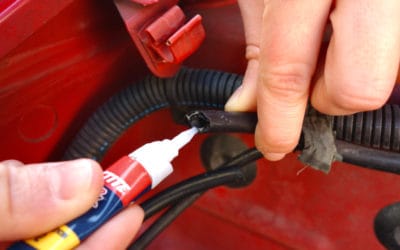When scissors get blunt, we usually opt for a new pair, ending with a pile of dull scissors. Yet, sharpening scissors is as easy as sharpening knives. Keep reading if you want to learn the best way to sharpen your scissors at home.
What is the Best Way to Sharpen Scissors?
The best way to sharpen scissors at home is sharpening by hand using a sharpening stone and a file. Those two tools will help you create a clean new edge that can be even better than when it came from the store.
TIP: As a sharpening stone alternative, you could use sandpaper on a hard surface.
Before You Start Sharpening
You should consider one crucial thing before sharpening your scissors, and that’s the scissor tension, i.e., how tight or loose are the scissor blades screwed to each other. If you have incorrect scissor tension, sharp blades won’t be enough to make your scissors cut well.
If the blades of your scissors seem sharp first try to set the proper scissor tension – click here to jump to the relevant section of this article.
If your scissor blades are blunt, follow the sharpening process below. We will address the correct tension in the last step.
5 steps to sharpen your scissors:
1. Clean the blades from any grime.
2. Inspect the inside face of both scissor blades. If you see rust, imperfections, or nicks along the cutting edge, you will need to refine the inside face of the blades by taking off a very fine surface. The perfect tool for this is a diamond plate (Amazon link). Alternatively, you can use 250-300 grit sandpaper placed on a flat hard surface or a waterstone. Here is a link to an affordable multipurpose stone that you can buy from Amazon. To refine the inside face of the blade:
– Optionally spray two spritzes of Windex onto the plate.
– Lay the blade the flat side down on the diamond plate and rub back and forth approx. 30 times. Black residue should start appearing on the plate. It is the old steel coming off. You should see a very narrow line of fresh steel along the cutting edge of the blade. That’s what we wanted.
Note: The inside of the blade will most likely stay untouched since scissors blades are usually hollow ground in the middle.
3. The next step is to draw file the bevel. For this, you can use a smooth single-cut file. It can be a flat, narrow file or a saw file (recommended file: Amazon link). You can also use a diamond plate (especially handy for harder steel) or a different type of sharpening stone. To draw file the bevel:
– Firmly secure the scissor blade in a vise with the flat side away from you.
– Position the file approx. 45° to the blade and drop your hand with the file to copy the original bevel angle (usually 10°). Use your free hand to hold the file on the other end – it will help you put equal pressure on the file.
– Pull the file from the beginning of the blade to the tip. Don’t push hard, pull making long easy strokes. The file should get in contact with the blade only on the stroke going from the beginning of the blade to the tip. Make sure to keep the edge leveled. You should end up with a shiny, flat steel surface on the whole length of the blade.
– As an optional finishing touch, use a diamond file (Amazon link) the same way. This finer tool will make the surface even smoother, giving you an extra sharp edge.
4. Open and close the scissors as usual. If you feel some friction between the blades, it is probably a burr. A burr is the very tip of the cutting edge that should be positioned straight for the best cutting performance. However, when sharpening, the burr tends to flip to one side. To straighten the burr, open and close the scissors a couple of times. The friction should disappear.
5. The last step is to set the correct tension (click here to learn more about the scissor tension). Position the scissors vertically with the tip pointing to the ceiling. Lift one handle to 3 o’clock and let it go. It should stop between 4 and 5 o’clock. If it stays at 3 o’clock, it is too tight. If it closes completely, it is too loose. Adjust the tension tightening or loosening the tension screw.
How to Tell if Scissors are Sharp
Now the only thing left to do is to test the sharpness of your scissors. Try to cut a wet one-ply toilet paper, tissue, or paper towel. Sharp scissors with correct tension should cut the wet paper all the way to the tip.
The pinnacle of sharpness would be cutting the wet paper vertically, keeping the scissors closed, and pulling down. The wet paper shouldn’t get pulled or come down with the scissors.
Before the Test Cut
Since the performance of scissors is affected not only by the sharpness of the scissor blades but also by the correct tension, etc., it is essential to perform a couple of steps before the actual test cut:
- Clean your scissors from any grime.
- Optionally lubricate the inner blades with WD-40 or other lubricating oil.
- Check if there is correct tension in the scissors (click here to go to the relevant section in the article).
Sharpening Scissors with a Waterstone
To sharpen scissors using a waterstone, follow the 5 steps explained above, replacing step 3. with the process described below.
Step 3. Using a Waterstone
Place the blade on the stone with the flat side facing you. Position the blade so that the bevel is aligned to the stone. Push the blade away from you, lift and start again. You can slightly change the angle to make sure that you get right to the cutting edge. Repeat this stroke until you see a shiny, flat steel surface on the whole length of the blade. When you are done, rinse the blade with water.
The Next Best Thing
Even though sharpening scissors with a stone or a file is not hard, it does require some knowledge and practice. If you don’t like this solution, try specialized scissor sharpeners. Such sharpeners will set the angle to sharpen your scissors for you. It won’t be as perfect as manual sharpening, but it will get the job done.
I recommend one of these two scissor sharpeners from Amazon. They both have great reviews. One is a classic scissors sharpener, and the other is a 4 in 1 scissor and knife sharpener.
What is the Scissor Tension
The scissor tension refers to how tight or loose are the scissor blades screwed to each other.
If the tension is too loose, there will be a larger gap between the blades, and the scissors will bend rather than cut whatever you’re cutting. Sharp scissors might appear dull only because they have incorrect tension.
Sharp scissors might appear dull only because they have incorrect tension.
On the other hand, if the tension is too tight, the scissors will feel stiff. It will be harder to close them, which will lead to fatigue. Also, the scissor blades will rub together, which will make them blunt very quickly.
How to Test the Correct Tension
If the handle stays at 3 o’clock, it is too tight. If the scissors close completely, it is too loose. Good tension is when the handle stops between 4 and 5 o’clock.
TIP: Before testing the correct tension, make sure that your scissors are clean. You can also lubricate your scissors, adding a bit of oil between the blades (e.g., WD-40).
How to Adjust the Tension
For the most part, adjusting the tension is a matter of simply tightening or loosening the tension screw and repeating the tension test described above until you are happy with the result.
There are many types of adjusters of the tension (tension screws). Scissors might be adjusted by hand, with a special key or a screwdriver.
Adjusting the tension of scissors with a rivet is a bit tricky. It is easy to tighten them but hard to undo it. To make the tension tighter, you will need to pound the rivet once or twice with a hammer. Check the new tension often to make sure that it is not getting too tight. If you went overboard, to loosen the tension, you would have to, e.g., rub the inside of the scissor blade with a sharpening stone as described in step 2. above. You probably won’t need a lot. Start with five strokes back and forth on each blade and repeat if needed.
Does Cutting Aluminum Foil Sharpen Scissors?
Cutting aluminum foil does not sharpen scissors. Don’t get me wrong. Yes, it might improve the performance of your scissors for a while but technically, cutting aluminum foil does not sharpen scissors. Here is why.
Sharpening vs. Maintenance
Sharpening can be described as creating a new edge or refining the edge of a cutting tool. To do that, you need an abrasive material that is harder than the cutting tool itself. Since aluminum has a hardness value of 2.5-3 on the Mohs scale and steel varies between 4-8 (depending on the type), you can not use it to sharpen steel scissors.
Using aluminum foil should be viewed as a maintenance procedure. It doesn’t sharpen scissors. Instead, it might remove dirt or straighten the burr, making scissors cut better. But it is a temporary fix and a redundant step. If your scissors have correct tension (to learn more about scissor tension, click here), just by opening and closing them, you get similar results as when cutting aluminum foil (source).
Does Cutting Sandpaper Sharpen Scissors?
By cutting sandpaper, you can sharpen your scissors. Contrary to aluminum foil, you can get sandpaper that is harder than steel (you can use 250-300 grit) which will sharpen the scissor blades.
According to a professional sharpener (source), cutting sandpaper is the only method he advises for a temporary fix. However, this method is not suitable for every type of scissors (e.g., Kevlar or high-end beauty). Moreover, to properly sharpen scissors, you have to create a new edge on a particular angle. This is not the case when cutting sandpaper. In the long run, you are likely to destroy the cutting edge.
According to a professional sharpener (source), cutting sandpaper is the only method that he advises for a temporary fix. However, this method is not suitable for every type of scissors (e.g., Kevlar or high-end beauty). Moreover, to properly sharpen scissors, you have to create a new edge on a particular angle. This is not the case when cutting sandpaper. In the long run, you are likely to destroy the cutting edge.









0 Comments